Photographing Through Crowds (the Bali Saraswati Celebration)
It was my fortune that my last visit in Bali coincided with the Saraswati celebration. However, capturing ceremonies in Hindu Bali is not that easy. Temples would be far too packed to get photographic elbow room. While temples are generally open to the public – the Balinese are fairly tolerant and accommodating people – I always get stymied by fear of intruding too much in their religious observances.
I will describe here several tips in capturing Balinese ceremonies, specifically in making the crowds work for you photographically.
The challenge
To give you an idea of the difficulty, here is one picture at the Temple of Tangkas Puri Agung in Klungkung which happened to be celebrating its temple anniversary that day. The jostling crowd can be seen charging out of the first inner courtyard of the temple after a blessing. As temple courtyards can typically accommodate only a hundred people at a time, blessing rites have to be repeated all throughout the day, from morning and even into the night, to accommodate the thousands who would pay homage.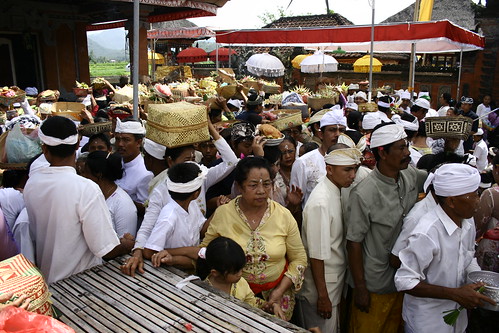
phototip: Be unobstrusive and wear Balinese attire. As ceremonies are repeated in cycles, staying over for the next rite allows you to choose which spot gives you the better vantage point.
f/4.5, 0.002s, 18mm, ISO 200, +1/3EV
Pura Tangkas Puri Agung, Klungkung, Bali, Indonesia
1. Distill the essence of the celebration
Now, back to the ceremony. Saraswati, in Hindu Bali, is the goddess of learning. During this holy day, the Balinese, most particularly the youth, would pray for scholastic success in temples all throughout the island. As in most rituals in Balinese temples, people come in the inner courtyard with offerings of food, flowers and incense. Praying is done by squatting position on the ground while sacred scriptures would be read over the mike and several times over, the worshippers would bow to the ground in unison. Finally, they would receive cooked rice and holy water from priests of the brahmana caste. The cooked rice would be partly eaten while some rice kernels would be pasted over their forehead. The water would be also be drank and sprayed over their heads, as shown below. 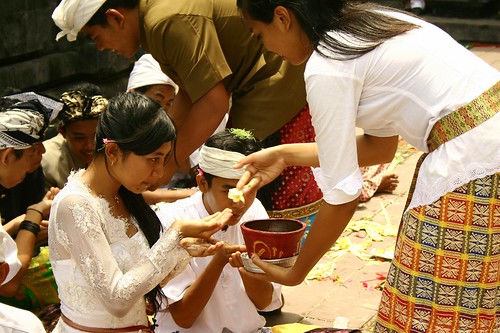
phototip: Capture the essence of the ceremony. Saraswati is for and by the youth, as shown in this picture.
f/4.6, 0.008s, 49mm, ISO 100, +1/3EV
Goa Lawah Temple, Klungkung, Bali, Indonesia
We visited a total of 3 temples that morning- the Pura Tangkas Puri Agung, the Pura Goa Lawah Temple (the famous bat cave temple) and the Pura Bukit Buluh, which has a tall 11-tier pagoda perched on a hill. However, the youthful celebration of the Saraswati offerings is best depicted in a series of pics I took at the village hall of Kusumba, Klungkung.
Apparently the blessing ceremony in the village of Kusumba was scheduled after lunch and in the morning, as entertainment prelude, classical dances were performed by local children. As families actually pay for their children to learn Balinese dance, the Saraswati was a special recital occasion.
2. Isolate a subject
Knowing that the Balinese are the more discerning critics and not the paying tourists (and there were none in the hall I visited), the dancers of various ages were obviously edgy and were practicing movements while performances were ongoing in the center stage. Find someone who stands out. Think of someone pretty. Someone in a gorgeous costume. A child. It might not be easy as the people around the subject often would block your view. Yet soon enough, the crowd will part. For the picture below, I followed a pretty girl in a fabulous headdress for sometime until finally, she looked at me.
phototip: Portraits, particularly the candid ones, are stronger if the subject looks back at you, straight into the lens.
f/5.6, 0.004s, 140mm, ISO 400
Kusumba Village, Klungkung, Bali, Indonesia
3. Tell a story
Cultural performances are visually attractive by themselves but watch out for crowd action that is organized, as opposed to random. In this photo, a masked topeng dancer was obviously trying to entertain a young boy. The spectators, young and old, sitting or standing, are all looking at the boy, in anticipation of his reaction. Although the boy was partly blocked from my view, there is a cohesive story unfolding in the drama. All eyes definitely were on the boy, as eventually yours would too.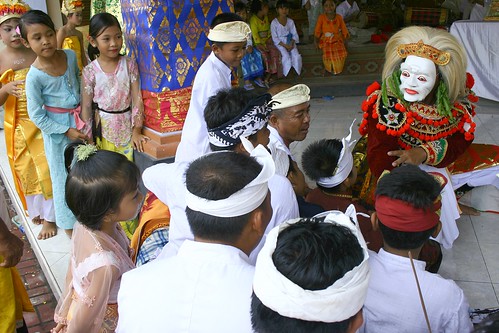
phototip: Watch out for scenes when eyes, gestures and movements are oriented towards one focal subject.
f/5.6, 0.006s, 222mm, ISO 200
Kusumba Village, Klungkung, Bali, Indonesia
4. Look behind the scenes
Interesting actions are not just limited in the stage. What is happening behind the scenes can be as fascinating as the dance performances. Getting backstage is easy in a Balinese village hall, which is just a quadrangle pavilion that is open in all sides. Besides, the Balinese don’t mind the occasional stranger like me.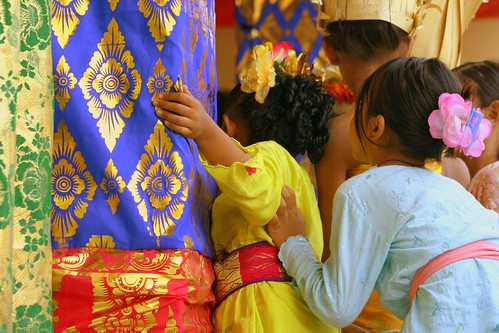
phototip: Watch out for colors. I shot this knowing that the contrasts of the girls’ dress against the colorful brocade would be stark.
f/5, 0.005s, 75mm, ISO 200, +2/3EV
Kusumba Village, Klungkung, Indonesia
5. Use the crowd as frame
Candid moments are happening everywhere so be quick. Once I saw that there were young dancers sitting in a corner waiting for their turn to dance, I recognized that their idle gossip was a photo op. The problem was that the girls were moving all the time. So I waited. When the girl in the right suddenly bent slightly and gracefully, I was ready. Sometimes you have to create your luck.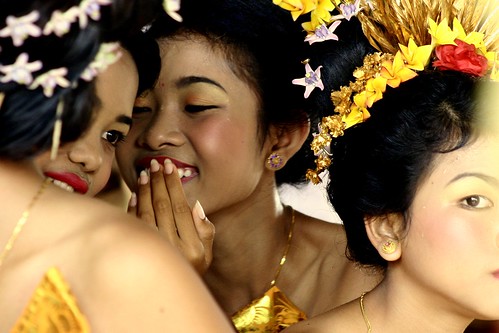
phototip: Use the crowd as frame for glimpses of intimate moments.
f/5.0, 0.008s, 150mm, ISO 800, +2/3EV
Kusumba Village, Klungkung, Bali, Indonesia






3 comments:
A very good story Farl. I've always knew that your blog, now that you have one, will be interesting. I never knew Bali up close and personal like you. so I'm always exciting everytime I read your stories.
And if I can learn some lessons from you: first to know your tools/medium (that is the camera). second is to know your surrounding. you will make good pictures if you know the place, the people, and their culture :)
Thanks for sharing, Farl.
This is a nice story Farl. I've always knew that your blog, now that you have one, will be very interesting. I never knew Bali as deeply as you are, which is shown through your amazing photos and stories of Bali. That's why I always find reading your stories as a very exciting experience.
And if I can learn some lessons from you. One is to know your tool/medium - the camera. Two is to learn about your surrounding. You will have better chance to make good photos if you know the place, the people and their culture.
Thanks for sharing, Farl. And please forgive me if you receive double comments from me because my browser quit unexpectedly while I'm posting my first comment :)
This is a great site. Keep on writing and taking these marvelous photos.
Post a Comment